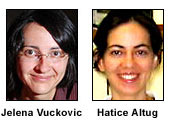STANFORD, Calif., Nov. 8 -- Researchers at Stanford University have used an array of coupled photonic crystal nanocavities to develop a new kind of laser that could lead to drastically faster speeds in telecommunications and networking equipment, spectroscopic sensing and optical image processing.
 Because light can carry huge amounts of data, lasers are vital components in modern communications. But current solid-state laser technologies, used in telecommunications and networking equipment, are fast reaching the limits of their capabilities. Now a new type of solid-state laser developed by electrical engineering assistant professor Jelena Vuckovic and doctoral student Hatice Altug could change all that.
Because light can carry huge amounts of data, lasers are vital components in modern communications. But current solid-state laser technologies, used in telecommunications and networking equipment, are fast reaching the limits of their capabilities. Now a new type of solid-state laser developed by electrical engineering assistant professor Jelena Vuckovic and doctoral student Hatice Altug could change all that.
In the Oct. 31 edition of the journal Optics Express, Vuckovic and Altug report on how they developed a new type of laser composed of coupled photonic crystal nanocavities that is 20 times more efficient and puts out 100 times more power than single photonic crystal cavity lasers.
"A single-mode laser that can be turned on at low "pump" powers, modulated, or turned on and off, at high speeds, and that can produce sufficiently high output powers is crucial for a number of applications," Vuckovic said in a written statement.
Those applications range from optical telecommunications and optical interconnects to spectroscopic sensing and optical image processing. The most immediate application for the new laser would be in speeding up optical networks, such as those that carry phone conversations between cities or reams of data within corporate networks. The current technology, vertical-cavity surface-emitting lasers (VCSELs), is comparatively energy-inefficient and cannot generate data (i.e., be modulated) faster than 20 billion b/s. A telecommunications industry goal is to be able to transfer data at 40 billion b/s in the near future. Vuckovic says her laser theoretically can operate at rates exceeding 100 billion b/s, easily meeting industry needs.
Vuckovic and Altug also can build lasers that operate at different wavelengths, which could be useful for "multiplexing," or sending several different wavelengths of light —- each one transmitting its own stream of data —- down the same cable.
The new laser is based on a photonic crystal, a square "layer cake" of indium phosphide-based material that is 300 nm thick and that is etched to create an array of regularly spaced, 400-nm-wide holes through the cake. At regular intervals among the holes are areas where no hole has been etched, called microcavities, which trap light. The filling of the layer cake is four layers of indium gallium arsenide phosphide. Each layer is called a "quantum well."
When Vuckovic shines pulses of light onto the crystal, the energy that the light "pumps" into the quantum wells excites them to emit light of a desired wavelength. That light then bounces around in the microcavities and back into the wells again, setting off a chain reaction of light emission from the crystal that produces a laser beam.
Researchers recently have made lasers using just a single photonic crystal microcavity in an attempt to outdo VCSELs. But single-cavity lasers are way too weak, emitting only a few billionths of a watt (a common light bulb emits 60 W) when hundreds of millionths of a watt of light is pumped in. Vuckovic and Altug's laser successfully combines 81 microcavities (in a 9 by 9 array) to make it more powerful, and it operates with greater energy efficiency. In the experiments Vuckovic and Altug describe in their paper, their laser was about 20 times as efficient as single-cavity lasers, putting out 100 times more power (12 millionths of a watt when pumped with 2.4 thousandths of a watt).
The laser is also incredibly small -- about 400,000 lasers could fit within a square centimeter chip -- which may be less costly to make and easier to integrate into electronic devices. Vuckovic and Altug still must demonstrate that their laser modulates faster than VCSELs, but they have strong reason to believe it can, because in research published earlier in 2005, Vuckovic reported a technique for controlling the duration of light pulses emitted from photonic crystals, meaning she can turn photonic crystal light emission on and off at a rate exceeding 100 billion b/s. The next step is to demonstrate that in a photonic crystal-based laser.
Vuckovic and Altug also have several other projects they are pursuing, one of which is improving laser energy efficiency further. They also want to power the laser with electricity rather than pumping it with light and they want to explore integrating the laser with computer chips to bring optical data transmission into computers, potentially speeding their operation.
For more information, visit: www.stanford.edu